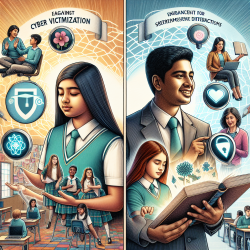Introduction
In today's digital age, cyber victimization (CV) has become a pressing concern for middle and high school students. With the increasing use of electronic media for communication, the risk of online bullying and victimization has grown significantly. A recent study titled Varying Experiences of Cyber Victimization among Middle and High School Students sheds light on the differences in CV experiences across gender and school levels, offering valuable insights for practitioners aiming to improve school environments and student outcomes.
Key Findings
The study analyzed data from 286 middle school (MS) and 304 high school (HS) students, focusing on the prevalence and types of CV acts experienced by boys and girls. The results highlighted several critical points:
- HS girls reported experiencing higher rates of CV than MS girls in most acts examined, particularly in receiving mean messages and having embarrassing content posted online.
- HS girls and boys reported similar rates of CV, except for HS girls experiencing more negative comments about them.
- CV was associated with lower school attachment, but not with perceived school safety when traditional forms of victimization were considered.
Implications for Practitioners
Understanding the nuances of CV is crucial for practitioners working in educational settings. Here are some actionable steps to consider:
- Focus on School Attachment: Since CV is linked to lower school attachment, interventions should aim to strengthen students' connection to their school. Programs that foster a supportive school climate and encourage positive peer interactions can be beneficial.
- Gender-Specific Strategies: Given the higher rates of CV among HS girls, targeted interventions that address the unique challenges faced by female students can help mitigate the negative impacts of CV.
- Comprehensive Monitoring: Schools should implement policies that monitor electronic communications during school hours to prevent CV. Educators and counselors should be trained to recognize signs of CV and provide appropriate support.
Encouraging Further Research
While this study provides valuable insights, there is a need for further research to explore the long-term effects of CV and its impact on diverse student populations. Future studies should consider factors such as race, ethnicity, and non-binary gender identities to develop more inclusive and effective interventions.
Conclusion
Cyber victimization is a complex issue that requires a multifaceted approach to address effectively. By understanding the specific experiences of different student groups, practitioners can develop targeted strategies to enhance school environments and promote positive outcomes for all students. To read the original research paper, please follow this link: Varying Experiences of Cyber Victimization among Middle and High School Students.










